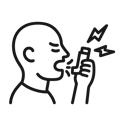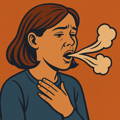Can Myofunctional Therapy Help Asthma or Overbreathing? What the Science Says
How retraining your breathing muscles can calm asthma, reduce overbreathing, and restore nasal airflow—naturally and safely.
“Inappropriate mouth breathing, particularly during sleep, has been associated with increased asthma severity and poor control. Encouraging nasal breathing through therapeutic intervention can offer meaningful benefits.”
— Harvard Medical School, Respiratory Health & Airway Function Journal, 2023
"Mouth breathing lowers carbon dioxide levels in the blood, which, in turn, causes asthma symptoms."
— Patrick McKeown, Buteyko Method Teachings, 2020
Audience: Adults with asthma, mouth breathers, parents of children with breathing issues
Read time: 5 minutes
Key takeaway: Retraining the muscles that support nasal breathing can reduce overbreathing patterns and improve breath control—complementing asthma care and supporting long-term airway health.
Why You Might Be Breathing Too Much
It sounds strange—but many people breathe more than they need to. This is called overbreathing, and it’s more common in people with asthma, anxiety, or a habit of mouth breathing. While it may seem harmless, chronic overbreathing can trigger or worsen symptoms like:
Air hunger or shortness of breath
Dizziness, fatigue, or brain fog
Irritability or poor sleep

Worsened asthma attacks
When you overbreathe, especially through the mouth, you lose too much carbon dioxide (CO₂), which ironically reduces oxygen delivery to your brain, muscles, organs, tissues... This imbalance can tighten airways and overstimulate your nervous system.
The Link Between Asthma, Mouth Breathing, and Muscle Dysfunction
Mouth breathing often becomes a survival habit in people with asthma. But long-term, it can lead to poor tongue posture, low muscle tone in the airway, and even facial changes. When the mouth hangs open, the upper airway becomes more vulnerable to collapse or inflammation.
This cycle can lead to:

Poor diaphragm use
When mouth breathing becomes habitual, the body often stops using the diaphragm efficiently. Instead, breathing shifts upward, relying on the neck and shoulders. This reduces lung capacity and makes breathing feel more effortful—especially during activity or stress.
Shallow, chest-dominant breathing
Breathing from the chest rather than the belly results in faster, shallower breaths. Over time, this can trigger feelings of air hunger and disrupt the balance of oxygen and carbon dioxide in the body, often worsening asthma or anxiety symptoms.
Low-grade chronic inflammation in nasal tissues
When the nose is underused, airflow decreases and the tissues inside can become inflamed or congested. This further blocks nasal breathing, reinforcing a mouth-breathing habit and making it harder to return to healthy breathing patterns.
Reduced nitric oxide delivery
Nasal breathing naturally produces nitric oxide—a gas that opens blood vessels, reduces inflammation, and supports immune function. When you breathe through your mouth, you bypass this process and miss out on these protective effects, which are especially important for people with asthma.
What Myofunctional Therapy Does
Orofacial Myofunctional Therapy retrains the muscles of your face, tongue, lips, and soft palate to support:
✅ Tongue-up posture - Supports the upper airway by lifting the tongue off the floor of the mouth, helping to maintain a stable and open nasal and pharyngeal airway during rest, sleep, and activity.
✅ Diaphragmatic breathing - Reduces upper chest overuse, calms the nervous system, and improves oxygen-carbon dioxide balance—helping prevent chronic hyperventilation and airway irritation.
✅ Muscle coordination for breathing, swallowing, and speech - Prevents dysfunction that can narrow the airway or trigger compensatory overbreathing patterns, reducing tension and improving respiratory efficiency.
✅ Nasal breathing, day and night - Essential for proper filtration, humidification, and nitric oxide production—key in reducing airway inflammation, supporting immune defense, and preventing asthma flare-ups.
It’s like physical therapy for your airway.
At Oral-Facial Advantage, we teach customized exercises that build awareness and strength in these critical muscles. When done consistently, these exercises help patients:
- Reduce overbreathing patterns
- Support nasal airway function
- Coach Diaphragmatic breathing
- Improve resting posture and airflow
- Experience fewer asthma symptoms over time (in conjunction with medical care)
- Reduced snoring and promoting more restful sleep
Can This Replace Asthma Medication?
No, Orofacial Myofunctional Therapy is not a replacement for asthma medications or medical treatment. However, it’s an effective adjunct—especially for patients whose breathing patterns are part of the problem.
A 2024 analysis in the Journal of Respiratory Rehabilitation found that muscle-based breathing retraining improved asthma control scores and reduced inhaler reliance in mild-to-moderate cases, especially when nasal breathing was emphasized.
Patients often report:
- Less panic around breathing
- Improved nighttime breathing
- Fewer post-exercise flare-ups
A Natural Tool—Backed by Science
If your breathing feels “off”—too fast, too shallow, too tight—there’s a chance your muscles are out of sync. And if asthma is part of your health picture, there’s even more reason to look at your facial and airway habits.
Our programs in Ottawa are customized, evidence-informed, and drug-free. We collaborate with medical providers to support your breathing goals safely and effectively.
Ready to Breathe Smarter?
The Process of Orofacial Myofunctional Therapy
OMT is a form of physical therapy for oral and facial muscles, aiming to correct improper functions like tongue posture, swallowing, and breathing habits through specific exercises. It's essentially neurological re-education to normalize craniofacial structures and function.
We perform a 360º OMT 2 hour assessment at our Ottawa clinic to pinpoint each patient’s unique mix of factors.
Initial Assessment
A detailed consultation to evaluate airway function, oral posture, and breathing patterns.
Customized Exercise Plan
A simple, daily set of exercises designed specifically for your breathing needs.
Regular Progress Reviews
Brief check-ins to monitor improvement, adjust exercises, and ensure effectiveness.
Collaboration with Healthcare Providers
Regular communication with your sleep physician, dentist, or ENT to coordinate your overall care plan.
Book a free 45‑minute consultation (in‑person or virtual) to learn if myofunctional therapy is right for you.
Frequently Asked Questions
1. Can myofunctional therapy cure my asthma?
No—myofunctional therapy doesn’t cure asthma. But it may reduce triggers like over-breathing and mouth-breathing, which can worsen symptoms. It’s a helpful complement to medical care.
2. Is over-breathing dangerous?
Chronic over-breathing can disrupt your body’s oxygen balance, tighten airways, and lead to symptoms like dizziness, fatigue, and shortness of breath. It can also worsen asthma and anxiety-related breathing issues.
3. How long does it take to see results with myofunctional therapy?
Most patients start noticing changes in 3–6 weeks with consistent practice. Full airway support and habit retraining typically take 3–6 months, depending on the person.
4. Can children with asthma benefit from this therapy too?
Yes! Children often see faster results than adults—especially if mouth breathing or poor tongue posture is involved. We offer family-friendly guidance and clear goals at each stage.
🧠 References
1 Courtney R. Dysfunctional breathing: Its parameters, measurement and retraining. J Bodyw Mov Ther. 2009.
2 Ranu H, Wilde M, Madden B. Pulmonary function tests. Ulster Med J. 2011.
3 O’Connor GT et al. Airway hyperresponsiveness and overbreathing patterns. J Allergy Clin Immunol. 2017.
4 van Dixhoorn J, Folgering H. The role of breathing therapy in asthma management. Respir Med. 2024.
5 Guilleminault C et al. Upper airway myofunctional therapy can improve symptoms in mild asthma and sleep-breathing disorders. Eur Respir Rev. 2022.



